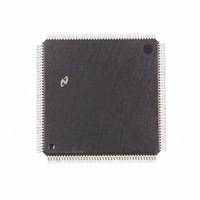DP83953VUL National Semiconductor, DP83953VUL Datasheet - Page 12

DP83953VUL
Manufacturer Part Number
DP83953VUL
Description
IC CTRLR RIC REPEATER 160-PQFP
Manufacturer
National Semiconductor
Datasheet
1.DP83953VUL.pdf
(90 pages)
Specifications of DP83953VUL
Controller Type
Ethernet Repeater Interface Controller
Interface
IEEE 802.3
Voltage - Supply
4.75 V ~ 5.25 V
Current - Supply
870mA
Operating Temperature
0°C ~ 70°C
Mounting Type
Surface Mount
Package / Case
160-MQFP, 160-PQFP
Lead Free Status / RoHS Status
Contains lead / RoHS non-compliant
Other names
*DP83953VUL
Available stocks
Company
Part Number
Manufacturer
Quantity
Price
Company:
Part Number:
DP83953VUL
Manufacturer:
HJC
Quantity:
2 010
Company:
Part Number:
DP83953VUL
Manufacturer:
Texas Instruments
Quantity:
10 000
4.0 Functional Description
The IEEE 802.3 repeater specification delineates the func-
tional criteria that all compliant repeater systems must
adhere to. An implementation of these requirements
strongly suggest a multiport modular design style. In such
a design, functionality is split between those tasks common
to all data channels and those exclusive to each individual
channel. The RIC2A follows this approach. Certain func-
tional blocks are replicated for each network attachment,
(also known as a repeater port), and others are shared.
The following subsections provide an overview of the
RIC2A architecture. First, RIC2A feature enhancements
from the RIC II is discussed. Then, the RIC2A functional
blocks are described.
4.1 Summary of DP83953 RIC2A Feature En-
hancements from DP83952 RIC II
1. The DP83953 RIC2A integrates transmit filters and driv-
2. The functionality of the DP83953 is essentially similar to
3. Integrated network port drivers provide controlled rise
4. Compared to DP83952, the DP83953 requires additional
4.2 Overview Of RIC2A Functions
Segment Specific Block: Network Port
As shown in the block diagram, the segment specific blocks
consist of
This function is repeated 13 times in the RIC2A (one for
each port) and is shown on the right side of the block dia-
gram, Figure 1.
The physical layer interface depends upon the port. Port 1
has an AUI compliant interface for use with AUI compatible
transceiver boxes and cable. Ports 2 to 13 are twisted pair
ports.
ers on a per port basis. These additional features allow
a system developer to add little more than external isola-
tion transformers in order to build fully secured/managed
hub products.
DP83952, but some of the pin definitions have been
modified to reflect the new integrated drivers and trans-
mit filters. Therefore, the RIC2A is not a drop in replace-
ment for the RICII . Additionally, power and ground pin
locations have been rearranged to accommodate addi-
tional pins.
and fall time output signals. These port drivers will facili-
tate EMI compliance without procuring additional com-
ponents.
current drive. The additional current is required to imple-
ment the new integrated drivers and transmit filters.
A logic section and a physical layer interface section.
The logic block is required for performing repeater oper-
ations upon that particular segment. It is known as the
“port” logic since it is the access “port” the segment has
to the rest of the network.
12
The four distinct functions inside the port logic block are:
1. The Port State Machine "PSM" performs data and colli-
2. The Port Partition Logic implements the segment parti-
3. The Port Status Register reflects the current status of the
4. The Port security configuration logic determines if the
Shared Functional Blocks: Repeater Core Logic
The shared functional blocks consists of the repeater Main
State Machine (MSM), Timers, a 32 bit Elasticity Buffer,
PLL Decoder, Receive and Transmit Multiplexors, and
Security Logic with 32 shareable CAM locations. These
blocks perform the majority of the operations needed to ful-
fill the requirements of the IEEE repeater specification.
When a packet is received by a port it is then sent via the
Receive Multiplexor to the PLL Decoder. Notification of the
data and collision status is sent to the MSM through the
receive multiplexor and collision activity status signals. This
enables the MSM to determine the source and type of data
to be transmitted and eventually repeated to all ports. This
information may be valid data or the jam pattern.
According to the IEEE repeater specifications, after a colli-
sion has been determined, the transmit data will be
replaced with a jam pattern consisting of a alternating ones
and zeros. (e.g. 1010...) for at least 96 bit times. If a colli-
sion occurs during the preamble, the address field, the type
field, or the data field the RIC2A will immediately switch to
the jam pattern to be transmitted to all ports.
If the RIC2A is configured for the "non-secure" mode, the
valid received data is transmitted to all of the other ports,
except the port which is receiving the packet.
If the RIC2A is configured for the "secure" mode, the
source and destination addresses within each packet are
first checked against the addresses of the local and shared
CAMs assigned to the port. Based on this comparison, and
the port configuration will be either:
1. A pseudo random bit pattern may be generated in the
2. The received data may be transmitted intact.
The data always remains intact on the Inter-RIC bus (IRB
to be described later) to allow any cascaded repeaters to
compare all destination addresses with their local CAMs. In
sion repetition as described by the IEEE repeater speci-
fication. For example, it may determine if this port should
be receiving from or transmitting to a particular network
segment.
tioning algorithm. This algorithm is defined by the IEEE
specification and is used to protect the network from mal-
functioning segments.
port. The system processor may access this register to
obtain port status information or to configure certain port
options, such as port disable.
transmitted or received packet will contain intact or pseu-
do random data. This logic consists of two dedicated
CAM locations per port for learning, storing, and compar-
ing port source addresses.
data field of the designated “secure” packet and then
transmitted to their respective port(s). Or,
www.national.com











